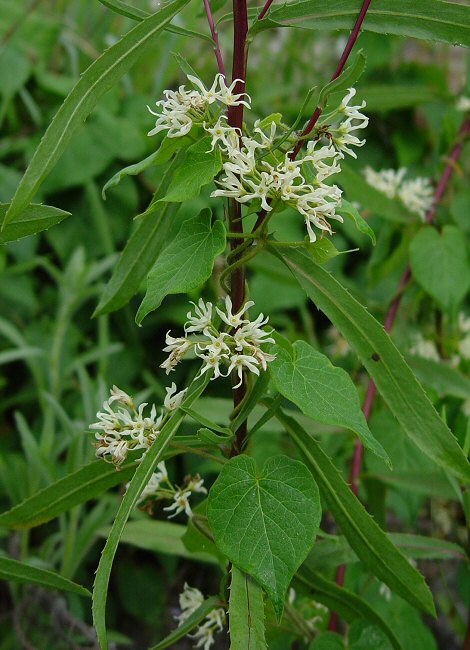Matelea baldwyniana (Sweet) Woodson
Climbing Milkweed

Native
CC = 8
CW = 5
MOC = 11
© DETenaglia
Matelea baldwyniana (Sweet) WoodsonClimbing Milkweed | |
 |
Native CC = 8 CW = 5 MOC = 11 |
© DETenaglia |
|
Family - Asclepiadaceae Habit - Perennial vining forb. Stems - Twining and climbing on other vegetation, to 3 m, herbaceous, brownish, with milky sap, hirsute and with glandular pubescence (some hairs with swollen glandular bases), from thickened roots.
Leaves - Opposite, simple, petiolate. Petiole 5-6 cm long, with same pubescence as stem. Blade 5-16 cm long, broadly ovate to orbicular, cordate, entire, acute to acuminate, scabrous above from swollen pubescence, appearing punctate because of swollen hairs.
Inflorescence - Solitary umbellate clusters in the leaf axils. Peduncles to 6 cm long. Pedicels to 2 cm long. Peduncles and pedicels with same pubescence as stem.
Flowers - Corolla white, 5-lobed. Lobes twisting, 7-13 cm long, 2-3mm broad, with same pubescence as stem externally, glabrous internally, blunt to slightly emarginate. Corona 5-lobed. Lobes to 0.5 mm long, alternating with appendages. Appendages to 0.8 mm long, often bifurcate. Pollinia minute, 0.1 mm broad, 0.3 mm long, with dark reddish-brown translator. Anther head discoid, 1.3 mm broad. Calyx 5-lobed. Lobes 3-4 mm long, lanceolate, spreading to slightly recurved, densely brown glandular.
Fruits - Follicles 6.5-9.0 cm long, tuberculate. Seeds 7-9 mm long, ovate, narrowly winged, the terminal tuft of hairs to 3 cm long, white to light cream-colored or tan. Flowering - May - June. Habitat - Glades, savannas, dry upland forest openings, bases of bluffs, on calcareous substrates. Origin - Native to the U.S. Lookalikes - Vegetatively similar to M. decipiens, but unmistakable when flowering. Some resemblance to Cynanchum laeve. Other info. - This is one of two species of the genus found in Missouri. It is far less common than M. decipiens and is mostly restricted to the southwestern corner of the state. Beyond Missouri its range extends only to portions of Arkanasa and Oklahoma, with a few uncommon populations also occurring in the deep South. It is easily identified when flowering from its opposite leaves, pubescent stems, and white flowers. The flowers have twisted petals. Photographs taken at Busiek State Forest, MO., 6-17-05 (DETenaglia); also at Drury-Mincy Conservation Area, Taney County, MO, 4-14-2012 (SRTurner). |